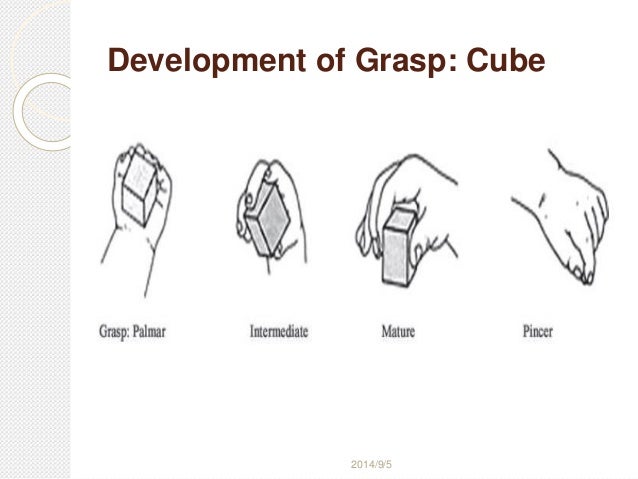Erhardt Developmental Prehension Assessment Pdf Files
Posted in HomeBy adminOn 28/01/18This video illustrates how the Erhardt Developmental Prehension Assessment (EDPA) is used to determine missing components of hand skills needed for functional activities such as feeding; the relationship of fine motor, gross motor, oral-motor, visual, and cognitive development; and methods of integrating treatment into a home program. A school-aged child with cerebral palsy begins independent feeding as all family members become involved. Vw Ecu Remapping Software Download. Rating: (not yet rated) Subjects • • • More like this •.
The Erhardt Developmental Prehension Assessment (EDPA) was designed as a measure of hand function for use with developmentally and physically disabled children. In this study the EDPA was revised (EDPA-R) by changing some of the test items, standardizing the procedures for administering the test and developing an objective scoring system. The inter-observer reliability of the EDPA-R, and the concurrent validity of the EDPA-R with the fine motor scale of the Peabody Developmental Motor Scales (PDMS) were evaluated. Thirty developmentally disabled children ranging in age from 3 to 18 months were tested in this study.

The results indicate that the EDPA-R has high levels of inter-observer reliability, and that it has concurrent validity with the PDMS in this population. Further test revisions are necessary, however, to improve the EDPA-R's discriminative power. L., Oliven, B.
Purpose: Documents the nature and extent of the functional characteristics of childhood disability. Purpose: Commonly used assessment in early intervention and preschool programs to determine developmental delay in several. ERHARDT DEVELOPMENTAL PREHENSION ASSESSMENT (EDPA) - Second Edition. HAND FUNCTION SERIES Early Hand Development. One of my first evaluation tools was The Erhardt Developmental Prehension Assessment (EDPA).
L., Johnson, C. Grasp and pinch strength in children 5–12 years old. American Journal of Occupational Therapy, 38, 107– 113.,, Bayley, N. Bayley Scales of Infant Development. New York: Psychological Corporation.
Benson, J., Clark, F. A guide to instrument development and validation. American Journal of Occupational Therapy, 36, 780– 800., Berk, R. A., DeGangi, G.
Technical considerations in the evaluation of pediatric motor scales. American Journal of Occupational Therapy, 33, 240– 244., Bobath, B., Bobath, K. Motor development in different types of cerebral palsy. London: William Heinemann. A primer of infant development.
San Francisco: W. G., Zeller, R. Reliability and validity assessment. Beverly Hills: Sage Publications., Cronbach, L.
Coefficient alpha and the internal structure of tests. Psychometrika, 16, 297– 334., DiFranco, D., Muir, D. W., Dodwell, P. Reaching in very young infants.
Perception, 7, 385– 92., Erhardt, R. Developmental hand dysfunction: Theory, assessment, treatment. Maryland: Ramsco Publishing. P., Beatty, P. A., Hertsgaard, D. A developmental prehension assessment for handicapped children.
American Journal of Occupational Therapy, 35, 237– 242.,, Evans, D. M., Lawton, D. Assessment of hand function. Clinics in Rheumatic Diseases, 3, 697– 725. R., Fewell, R. The Peabody Developmental Motor Scales.
Allen, Texas: DLM Teaching Resources. A., Broman, M. The Purdue Pegboard: Normative data on 1334 school children. Journal of Clinical and Child Psychology, 8, 156– 162., Gesell, A., Amatruda, C. Developmental diagnosis. New York: Paul B. Gesell, A., Halverson, H.
The development of thumb opposition in the human infant. Journal of Genetic Psychology, 48, 339– 361. Griffiths, R.
The abilities of babies: A study in mental measurement. London: University of London Press. Halverson, H. An experimental study of prehension in infants by means of systematic cinema records. Genetic Psychology Monographs, 10, 107– 285. Halverson, H. Studies of the grasping responses of early infancy.
Journal of Genetic Psychology, 51, 371– 449. H., Taylor, N., Trotter, M. J., Howard, L. An objective and standardized test of hand function. Archives of Physical Medicine and Rehabilitation, 50, 311– 319., Kellor, M., Frost, J., Silberberg, N., Iverson, I., Cummings, R. Hand strength and dexterity.
American Journal of Occupational Therapy, 25, 77– 83., Kirshner, B., Guyatt, G. A methodological framework for assessing health indices. Journal of Chronic Disease, 38, 27– 36.,, Kleinbaum, D. G., Kupper, L. Applied regression analysis and other multivariable methods.
Boston: Duxbury Press. Fw 1804 Drivers. Kramer, M., Feinstein, A. The biostatistics of concordance. Clinical Pharmacological Therapy, 29, 111– 123.,, Law, M. Measurement in occupational therapy: Scientific criteria for evaluation.
Canadian Journal of Occupational Therapy, 54, 133– 138., Lundberg, A. The drawing test: A tool for assessment of arm-hand function in children of 1–3 years of age. Neuropediatrie, 10, 29– 34.,, Lundberg, A.
Gross and fine motor performance in healthy Swedish children aged fifteen to eighteen months. Neuropediatrie, 10, 35– 49.,, Maslany, G. W., Weston, M. Reliability and validity: Methods of analyzing measurements. Unpublished manuscript, Carelton University, Ottawa. Mathiowetz, V., Federman, S.
M., Wiemer, D. Box and block test of manual dexterity: Norms for 6–19 year olds. Canadian Journal of Occupational Therapy, 52, 241– 245., Mathiowetz, V., Volland, G., Kashman, N., Weber, K. Adult norms for the box and block test of manual dexterity.
American Journal of Occupational Therapy, 39, 386– 391.,, Missiuna, C. Dynamic assessment: A model for broadening assessment in occupational therapy. Canadian Journal of Occupational Therapy, 54, 17– 21., Pausano, R.J. Use of chronological and adjusted ages to compare motor development of healthy preterm and fullterm infants. Developmental Medicine and Child Neurology, 28, 180– 187., Skerik, S.
K., Weiss, M. W., Flatt, A. Functional evaluation of congenital hand anomolies. American Journal of Occupational Therapy, 25, 98– 104., Taylor, N., Sand, P. L., Jebsen, R.
Evaluation of hand function in children. Archives of Physical Medicine and Child Neurology, 54, 129– 135.